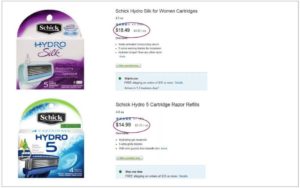It is no secret that women earn less than men serving in the same position. Would it shock you to learn that women also pay more for the same stuff?
The most recent statistics from the U.S. Census Bureau show the median earnings for men holding full time positions in Iowa as $47,202. Women in Iowa working full time had median earnings of $36,522. For every dollar an Iowa male makes, a woman brings home 77 cents. If race is brought into the equation, women of color fare even worse.
While the gap may seem small, those pennies add up. Women not burdened by the wage gap would earn enough to pay for 18 months of food for her family, or 15 months of rent, based on Census Bureau averages.
Unfortunately, while women are being shortchanged in income, they’re also being swindled at the cash register. At least that’s the news from a report issued in December by the New York City Department of Consumer Affairs, “From Cradle to Cane: The Cost of Being a Female Consumer.”
The group found distinct price differences between everyday goods marketed to women and goods marketed to men. The study looked at personal care items, adult and children clothing, toys and products for older adults. Here’s what they found:
• Across all the various product types, goods marketed to women cost 7 percent more than those marketed to men.
• Hair care products for women were more than 45 percent more expensive than those for men. On average, shampoo and conditioner marketed to women costs nearly $3 more per bottle.
• A child’s scooter — identical except for color and one being labeled a “sports scooter” and the other a “girl’s scooter” — was 50 percent higher for girls than boys, $49.99 compared to $24.99. On average toys and accessories marketed to girls are 7 percent more expensive than the boy counterparts.
• Female senior citizens that chose home health care products marketed to women pay an average 8 percent more.
• Boys’ clothing averages 4 percent less than girls’ clothing. Once in adult sizes, women can expect to pay 8 percent more than men.




The findings echo the group’s 1992 investigation that women pay more than men at used car dealers, dry cleaners, launderers and hair salons. A 1994 California study documented a “gender tax” of $1,351 per year. Other states have followed, and each has found the same discrepancy: Women, who earn less, are often paying more.
Some states followed California’s lead and enacted bills to protect consumers from price discrimination for services, a few doing so through a direct call-out of gender bias. But no entity has taken on the gender-based price gap for goods.
Researchers understand that their study was rarely an exact science. That is, products marketed by gender are rarely identical, which makes comparison difficult. Efforts were made to locate goods as similar in construction, ingredients, textile, appearance and description as possible.
For women, however, the message is clear. Sidestep the pink and find what you need in the men’s aisle.
This column by Lynda Waddington originally published in The Gazette on January 2, 2016.
